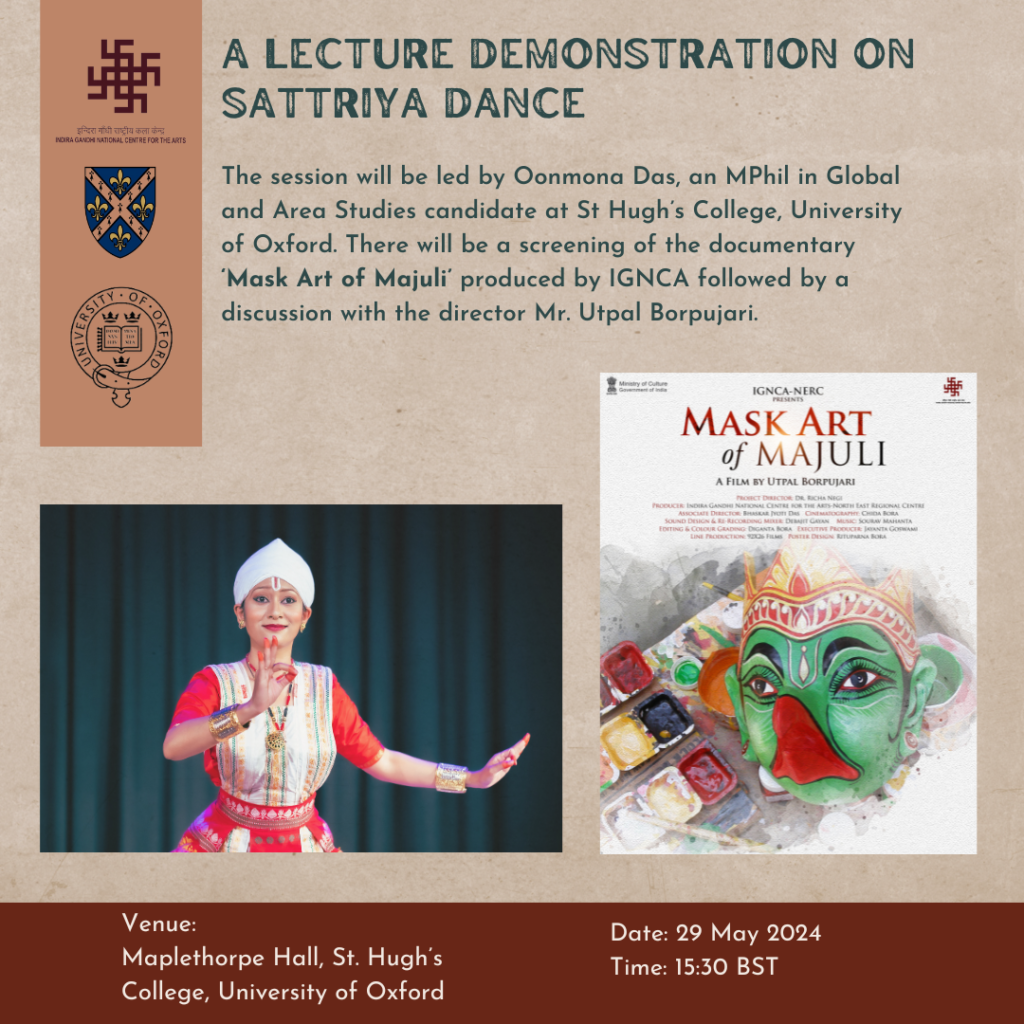Learn the art of Sattriya dance at St Hugh’s lecture-demonstration

St Hugh’s graduate student, Oonmona Das (MPhil Global and Area Studies) will be holding a lecture-demonstration on Sattriya dance on Wednesday 29 May at 3.30pm in Maplethorpe Hall.
Through this lecture-demonstration, Oonmona will lead an introductory session on Sattriya dance, covering the basics and philosophy of the dance form. Participants will have a chance to partake in the session where Oonmona will guide them in the basic grammar of Sattriya dance, known as “Mati Akhoras”. The session will also cover specific dance compositions within Sattriya dance that gives the form its uniqueness.
Following the lecture-demonstration, participants will be offered refreshments before the second half of the session which will be a screening of a documentary film entitled “Mask Art of Majuli”, which is about the mask-making tradition of the Sattras’, and is produced by Indira Gandhi National Centre for the Arts (IGNCA).
Mask-making is a significant part of the larger Sattriya culture and holds a crucial role during Ankiya Bhaona presentations. Following the screening there will be a discussion with the documentary director, Utpal Borpujari. This film creatively documents the Mask Art form of Majuli, focusing on the only two families that are keeping the practice alive at the Natun Chamaguri Satra, including award-winning mask-maker Dr Hem Chandra Goswami.
Sattriya Dance has its origin in the ‘Sattras’ (monastic institutions in Assam) established by Mahapurush Srimanta Sankardev in the 15th and the 16th century. The Sattras were established for the propagation of Vaishnavism and later became the religious, cultural, and social hub for the people of Assam. The great Vaishnavite Saint has developed this dance form with its basic roots aligned with the characteristics of other forms of Indian classical dance. Initially a part of the ‘Ankiya Naats’, this dance form derived its name from the word ‘Sattra’. This dance form was originally performed in the Sattras and the Namghars by the male Bhokots (monks) as part of their religious rituals and for spreading the philosophy of Vaishnavism, and remained confined within the four walls of the Sattras for several centuries. However, after independence, especially from the 1960s and 70s, Sattriya started spreading across the masses, especially amongst women, outside the Sattra institution. Now, the dance form is thriving as a performative art in India and abroad attracting curious learners from across the world.
The numerous Satras (Vaishnavaite monasteries) of Majuli, the world’s largest inhabited river island, are not only religious places of great significance but also form the heart of Satriya culture that was created by 15th century saint, poet, playwright, social reformer and cultural icon Srimanta Sankardev.
One key element of the Satriya culture is the masks that are worn by performers during Bhaona, which are dance dramas based primarily on Hindu mythology. These masks – or “Mukha” as they are called in Assamese – represent an intricate art form, and artisans create them in a unique and totally organic way using biodegradable material.
